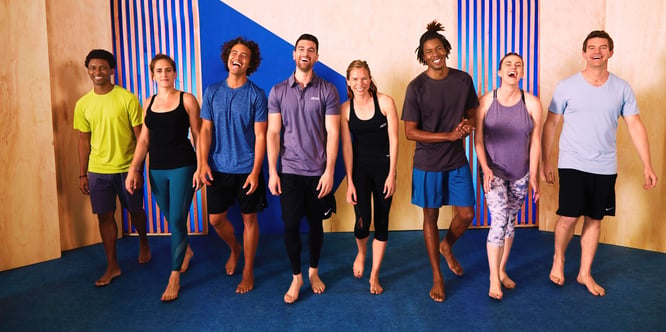Group Fitness Instructors have a unique skill set; they’re the masters of multitasking. They can effectively entertain, motivate, relate, count, smile, and point all at the same time while they have multiple people staring at them, waiting for direction.
Needless to say, the ability to do all of those things can be draining. Group Fitness Instructors spend so much time caring for others, which makes self-care an essential task for instructors hoping to avoid burnout, and even worse, injury.
A tribe of long-time instructors was asked what advice they have for their peers on keeping their body healthy, teaching longevity, and self-care. These are some of their most helpful tips and tricks.
1. Protect the Ears
In most cases, instructors never consider this part of the body until it becomes a problem. Whether you’re teaching at a large fitness convention or in a small studio class, ears can be affected by music or even your voice through the microphone.
Volume level is something for instructors to consider for their health as well as for the health of the class participants.
But just exactly how loud should music in class be? The Occupational Health and Safety Administration (OSHA) recommends music max volume is at 85 decibels (dB) for an hour-long class.
Get an application on your device that measures (dB)
Whether you have an Apple or Android phone – flip phones, you’re out of luck here -- you should be able to find a free app to measure (dB). Once you know what the volume levels are on the mixer or stereo, it can be marked. Keep in mind that many songs, especially older songs, will play at different volume levels, so it is helpful to keep the app and check volume levels often.
Keep earplugs in your instructor kit
When in doubt of the volume level, throw earplugs in. It will protect your ears without eliminating the beat. If you are the instructor, turn the volume down, but if you’re at a convention or place where you cannot control the volume level, earplugs are a must.
Avoid teaching and cueing directly in front of speakers
As sound waves travel, they weaken, so standing right in front of the speakers is a dangerous place for ears. As you move around the room, instructing and motivating, avoid the loudest spots such as the speakers.
2. Protect the Voice
Verbal cueing is such an essential part of group fitness instruction. When an instructor is not pointing or demonstrating, they are talking. An instructor's voice, just like hamstrings, needs to be cared for.
Use a microphone
The best way to save your vocal cords is to avoid situations that put undue stress on them. You can accomplish this by using a mic during class. Let the speakers do the projecting so you can focus on the message of what you’re saying and not how loud you’re saying it.
While this seems like a no brainer, many formats and clubs are now advocating for no microphones during instruction. In those cases, cue wisely and rely on pointing, directing, and visual cues.
Warm-up your voice before teaching
While it sounds like something you'd tell a singer, you wouldn't have a class participant doing something physically demanding without warming up. You don't want to do that to your vocal cords, either.
Like the aforementioned “professional singer” - start with humming, then move to repeating syllables with gradual breath flow and more volume.
Condense cues
Say what needs to be said to get the desired movements in the most concise way possible. Some great cueing tips include, “action, body part, where?”, “step leg back" or "reach arms up." Then, rely on modeling or mirroring to fill in the rest.
Teach with good posture
Modeling correct posture will not only benefit the participants in your class; it will also allow for deeper breaths using diaphragm breathing. The diaphragm's main job is to assist in breathing, so let the muscle do its job. When you roll your shoulders back, the core is set; the diaphragm has the greatest availability for movement. Stand tall, breath deep.
Rest the voice after classes
Just like class participants’ bodies need to recover after a workout, your voice and all that makes speech happen need a chance to recover as well. After teaching, take a few minutes of no talking with the intention of rest and recovery.
Keep throat lozenges in your instructor kit
Throat lozenges can help moisturize the throat when it gets sore from strain and stress. It’s a great act of self-care.
3. Protect Joints and Joint Movements
There are multiple joints throughout your body and they are the reason instructors can move the ways they can. When instructors teach the same classes or the same types of classes, they repeat the same movements over and over. With mobility and repetitive movements comes the risk of injury.
Model proper form
That seems obvious, but form gets lost and forgotten when the body gets fatigued. When teaching multiple classes a day, you place your body at risk. Whether it’s the first class or fifth class, keep the kinetic chain in mind.
Move less and cue more
Repetitive movements are a significant factor in causing joint injury. Model a couple of movements, keep the class moving, step away from the movement, and move around the room, motivating in different ways.
4. Protect the Feet
The feet are the unsung heroes of the group fitness instructor. Feet support, balance, shift and shuffle, and at the end of the day, they need some rest. Try massage, Epsom salt soaks, or even just simply putting your feet up after a long day of being on them.
Wear the right shoe
Just like the equipment you use in class, choosing the shoe that works best with the landmarks of the feet is imperative. There are different lengths, arches, and strides, so the shoe that works for one instructor may not work for another. Many running companies have stride specialists that can watch you walk or run and suggest the right supportive shoe.
Have an alternate shoe
As the shoe is worn, the cushion gets compressed. Most shoes can bounce back. After finding a shoe that works with landmarks and the foot's anatomy, buy two, or have two different pairs. Wear one, then give the shoe a day to bounce back.
Get rid of old shoes
Just like tires, shoes have a limit on miles as well. Check into that when purchasing shoes. The hours instructors teach can add up. Shoes do not last nearly as long for fitness professionals as they do for most others.
Wear gym shoes only in the gym
Life happens, and instructors often have to run to another meeting or the store after they teach. This extra activity can put excess wear and tear on shoes that are not necessary.
5. General Teaching Tips
Here’s a little of this and a little of that to help you.
Create a Teaching Kit
This can be in a makeup bag or a pocket in your gym bag. Your teaching kit is where you put all the things you may need when teaching. Keep it in your gym bag, handy for all emergencies. Here are some ideas to include:
- Auxiliary cord
- Phone adapter
- Microphone windscreen
- AAA, AA, C batteries
- Hair ties (even if you don’t use them, someone will ask)
- Chapstick
- Throat lozenges
- Face cleaning wipes
- Mini deodorant
- Bandages
- Tampons
- Tissues
- Mini portable Bluetooth speaker
- Pen
- Post its
- Tape
- Business cards
You’ll likely need many of these items at some point in your teaching career, but not how one might think! A tribe contributor commented on using tissue and her leg to sweep the hair off a dirty floor.
Schedule Time Between Classes
If fitness is a career, it feels good to crank out all the hours back to back. That is doing a disservice to participants. Breaks in between classes allow your body and voice to rest. It also allows your mind to reset and to focus on the next class. They also allow time to welcome each class participant in, as well as say goodbye properly without feeling rushed or making them feel rushed.
Use the “Showoffs” in Class
We’ve all got them in our classes; the members that know what moves are coming before the instructor cues them. The “showoffs” usually stand right in the front row and love doing the most challenging options. Point them out and have them show a more challenging option, while you stay at a less progressive modification.
Teach a Variety of Styles
Teaching the same class over and over gets to be redundant, and instructors can lose excitement about the movements. Educate, certify, and train in as many formats as possible. Changing up movements and class styles will keep instructors from getting burned out. A current trend in fitness is "coaching.” These are fitness classes where participants are coached through movements, and they are only modeled once or twice. It will cut down on repetitive joint movements and reduce burnout.
Self-Care
This is the most important tip, and it will look different for every person. Some instructors recommended Epsom salt baths, while others are into oils. Find the self-care practice that works best for you after a day of teaching and do it. Proper nutrition, supplements, pre-workout drinks, post-workout drinks, eight hours of sleep, naps, and water consumption are all tips that were stated over and over by the tribe of instructors.
There is an old yoga lesson: one can’t fill another’s cup using a bucket with holes. Figure out which self-care tips are the most appealing, then put them into practice to fill the bucket’s holes.


